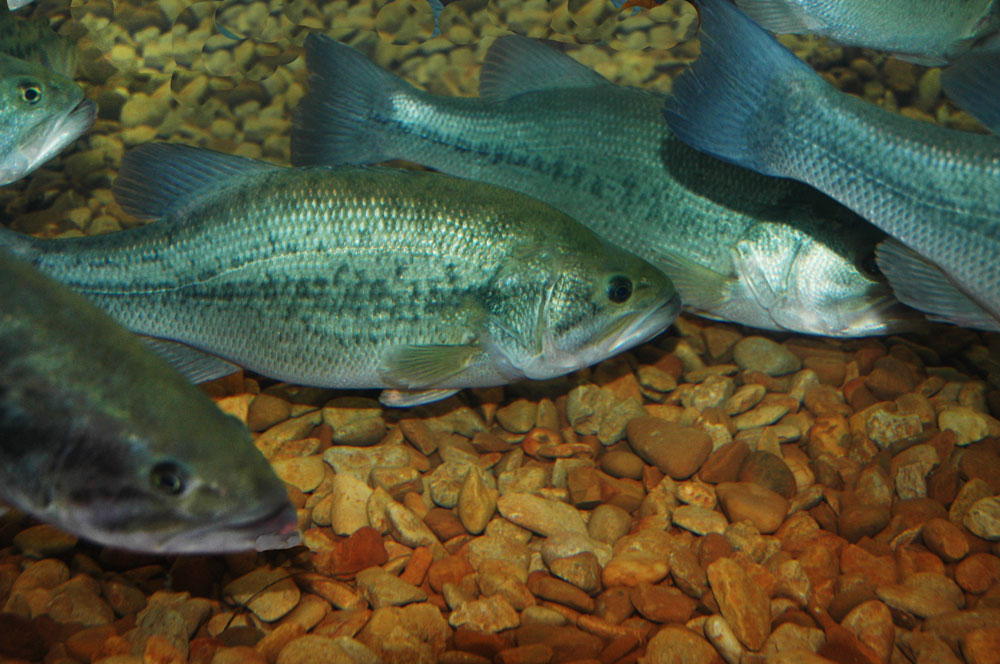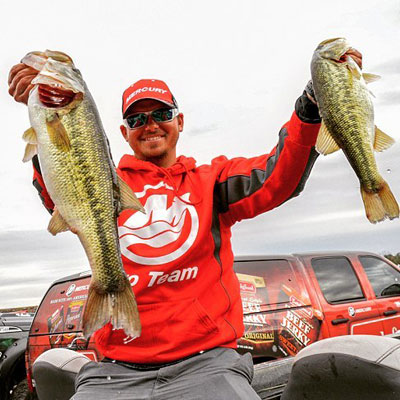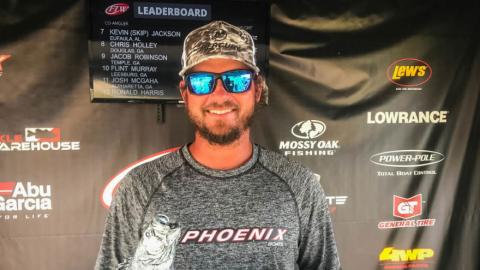provided by John E. Phillips
Thirty-two-year-old Drew Benton from Panama City, Florida, has been tournament fishing for 16 years. He began his tournament fishing career on the FLW Circuit and fished three seasons there, then moved to the Bassmaster Elite Series in 2016 and has qualified for the Bassmaster Classic for 3 years. Drew Benton finished third in the Bassmaster Elite Series Lake Eufaula tournament with 88 anglers on June 13, 2020, catching a total of 82 pounds, 4 ounces of bass to win $20,000.

Whenever I use a dropshot rig, I’ll use 15-pound test Seaguar braided line as my main line. Then to the braided line I’ll tie a 10-pound test Seaguar Invizx fluorocarbon line, 6-10 feet long, to the braided line with either an FG knot and/or an Alberto knot. I believe The FG knot to be a stronger knot that goes through the guides on your rod easier than the Alberto knot. But it takes me longer to tie that knot than it does to tie the Alberto knot that I can tie really fast. Once I initially tie my lure to my weighted line, I’ll tie the FG knot, but during the day if I break off my leader and have to tie the leader to the line a second time, I’ll use the Alberto knot.
Next, I’ll attach my dropshot hook, made by Owner. It’s a light-wire straight-shank hook with a small monofilament bait keeper on it, and my preferred size is a 2/0. After I have my hook tied on, I take the tag end of the line and run it back through the eye of the hook. Then that hook will stand parallel out from the line, and my knot will be down in the eye of the hook. I want to have about 12-16 inches of line below the hook, and on the end of the line is where I tie my weight. Then I’ll put a shaky-head worm made by Big Bites Bait on my hook. The colors I like to use are either green-pumpkin, morning dawn or plum. When my lead hits the bottom, I want a fairly tight line to hold the dropshot in the same place where the leads hit the bottom. That braided line will cause the plastic worm to start dancing, even though I’m keeping the line fairly tight. If I can’t get the bass to bite using this technique, I’ll use my LiveSight to determine what depth of water the bass are holding in, and then I’ll drop my dropshot straight down into the exact spot of the school where the bass are concentrating.
 One of the big advantages of the Lowrance LiveSight transducer is I can see my dropshot falling into the school. If one of the bass in the school follows the worm down to the bottom, there’s a pretty good chance it will bite. If the bass doesn’t bite the worm, I’ll use my trolling motor to back away from the worm and shake my rod tip a little bit, since I know the bass are looking at that worm. However, if I’m straight over the school, I think the school probably can hear my sonar popping. By backing away from the school where I think the bass can’t hear my sonar, sometimes the bass will bite. Another trick I’ll use is I’ll vertical fish the dropshot rig. I don’t set the hook when the bass takes the dropshot rig, I’ll just start reeling my spinning reel. Once I feel the weight of the bass, I pull my rod straight up. The secret to landing that fish is to make sure it can pull the drag off your reel, so that bass won’t straighten the hook because it’s only a wire hook.
One of the big advantages of the Lowrance LiveSight transducer is I can see my dropshot falling into the school. If one of the bass in the school follows the worm down to the bottom, there’s a pretty good chance it will bite. If the bass doesn’t bite the worm, I’ll use my trolling motor to back away from the worm and shake my rod tip a little bit, since I know the bass are looking at that worm. However, if I’m straight over the school, I think the school probably can hear my sonar popping. By backing away from the school where I think the bass can’t hear my sonar, sometimes the bass will bite. Another trick I’ll use is I’ll vertical fish the dropshot rig. I don’t set the hook when the bass takes the dropshot rig, I’ll just start reeling my spinning reel. Once I feel the weight of the bass, I pull my rod straight up. The secret to landing that fish is to make sure it can pull the drag off your reel, so that bass won’t straighten the hook because it’s only a wire hook.
I’d prefer to catch the bass by casting through the school, maybe dragging my dropshot 4-6 inches and stopping it again. But as a last resort, I’ll move straight on top of the school and fish straight down to the bass. I realize I’m risking scattering the bass if I pull my boat right on top of them, so I really hate to fish a dropshot rig vertically right on top of the bass. I know that most of the time when I put my boat right over the fish, I’ll scatter them. However, oftentimes I can get the fish to bite when nothing else works. When I’m dropshotting, I use a 7-foot, 1-inch Medium Feather Series Phenix Rod and a spinning reel with a quality drag system.



























